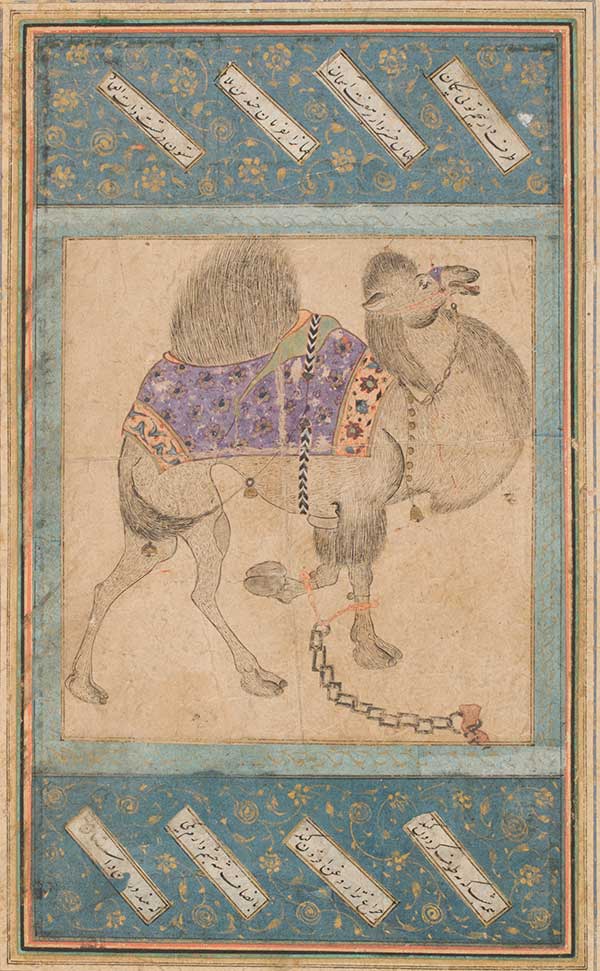
This fall, the Worcester Art Museum will examine an important period of art making in the Islamic societies of Iran and India, drawing on 40 key works from WAM’s collection. Preserved Pages: Book as Art in Persia and India, 1300-1800, organized by guest curators Hannah Hyden and David J. Roxburgh, will explore the ways in which the linkage between art and literature nurtured artistic developments across the region. The exhibition tracks the innovations in style and media created by artists?including painting, drawing and illumination?that was spurred by a growing interest in collecting single pages and assembling them into albums. Preserved Pages will be on view Oct. 13 through Jan. 6.
“For centuries in Persia and India, books and albums were the central vehicles for the production, dissemination and experience of artistic images. Many of these remarkable images feature vivid colors and abundant, intricate detail,” said Hannah Hyden, guest curator and doctoral student at Harvard University.
“With this exhibition, we want audiences to come away with both an understanding of the history of these artworks throughout the region and to cultivate an interest in the connections between the great literary traditions of India and Iran and the visual tradition that grew alongside it,” added co-curator David J. Roxburgh, Prince Alwaleed Bin Talal Professor of Islamic Art History at Harvard University.
Organized around a series of themes, the exhibition examines the range of contexts in which illustrated manuscripts were used?from epic works of poetry to capturing major moments in history?as well as how individual artworks were assembled into bound albums, and the emergence of certain styles, subject matters, and norms, such as including the name or signature of the artist. The first half of the exhibition will present famous literary works represented by folios from manuscripts, while the second half will focus on the album format and its artistic developments, all drawn from the Worcester Art Museum’s collection.
Specific sections of Preserved Pages include:
- A focus on the Sh?hn?ma (Book of Kings), Abu al-Qasim Firdawsi’s epic volume of poetry (c. 1010) comprising some 50,000 Persian couplets that captured Persia’s pre-Islamic royal history, and the Great Mongol Sh?hn?ma, which reflects the political, economic and cultural connections between Persia and China.
- The section on History and Biography explores how, beginning under the Mongols, Persian scholar-bureaucrats encouraged the production of histories which were illustrated. One of these?polymath and vizier Rashid al-Din (d. 1318)? composed a world history from the view of the Mongols, from prophets and patriarchs such as Adam and Muhammad through to the Islamic Abbasid dynasty (r. 750-1258). Rashid al-Din’s further innovation was to support the production of luxurious copies of his book and to have them distributed to major centers of learning. This process supported the dissemination of Persian history, while also nurturing the art of making such illustrated texts, which became a desirable means of embodying dynastic success.
- In The Album: The Art of Assembly, the exhibition explores the complex process of creating codex-format collections composed of various art forms including calligraphy, painting and drawing. Emerging in the 1400s in Iran, the concept of binding together individual, stand-alone artworks subsequently spread throughout the Islamic lands to Central Asia, India and Turkey (Anatolia) and also grew in complexity, as did the specialized skills needed to prepare the artworks for mounting in albums. Moreover, this section explores how, as the demand for albums grew, aspects of artistic production changed: calligraphers and artists started to make works speculatively with the idea that their art would be purchased, collected, and subsequently made up into albums.
- Examples of such changes in artistic production are further explored in Naming the Artist: the practice of artists signing their paintings and drawings, beginning in the 1500s, and the subsequent impact on encouraging more individualized artistic styles. As a wider variety of arts’ patrons from different classes and professions began to emerge, artists saw greater opportunities in making single-sheet artworks for sale. And as the idea of collecting such single-sheet works grew in popularity, so did the desire for more individualism in artistic expression.
- The final section looks at Women at Court. Powerful matriarchs were the norm within the Indian Mughal tradition, and women exercised great power from within the harem, often as avid patrons of the arts. At the same time, the imperial harem was also the setting for important ceremonies from royal marriages to funerals, as well as many religious festivals. In examining the depictions of women in this section, the exhibition connects the ideas within the art?often conceived by the male elites, and executed by male artists?with the tastes and topics of interest to India’s powerful female patrons.
“The Worcester Art Museum is fortunate to have an art collection of the Islamic world with great strengths in illustrated manuscripts and album pages,” said Vivian Li, Associate Curator of Asian Art and Global Contemporary Art. “Because these works are sensitive to light, they are rarely on view?so it is a great pleasure to be able to present them publicly together, in a show that explores many of the themes that are central to understanding the art and the history behind each object. We are grateful to Hannah Hyden and David Roxburgh for their creative development of this exhibition.”
At 6 p.m., Nov. 15, David J. Roxburgh, Prince Alwaleed Bin Talal Professor of Islamic Art History at Harvard University, will present a lecture, titled “Illustrating Epic Poetry and History in Persian Manuscripts from the Mongols to the Timurids.” A reception with cash bar and live music will follow. The event is free with museum admission. For more information, visit worcesterart.org.
PHOTO: Persian, An Irate Camel, (detail), 17th Century, Opaque watercolor on paper, Bequest of Alexander H. Bullock, 1962.185.






